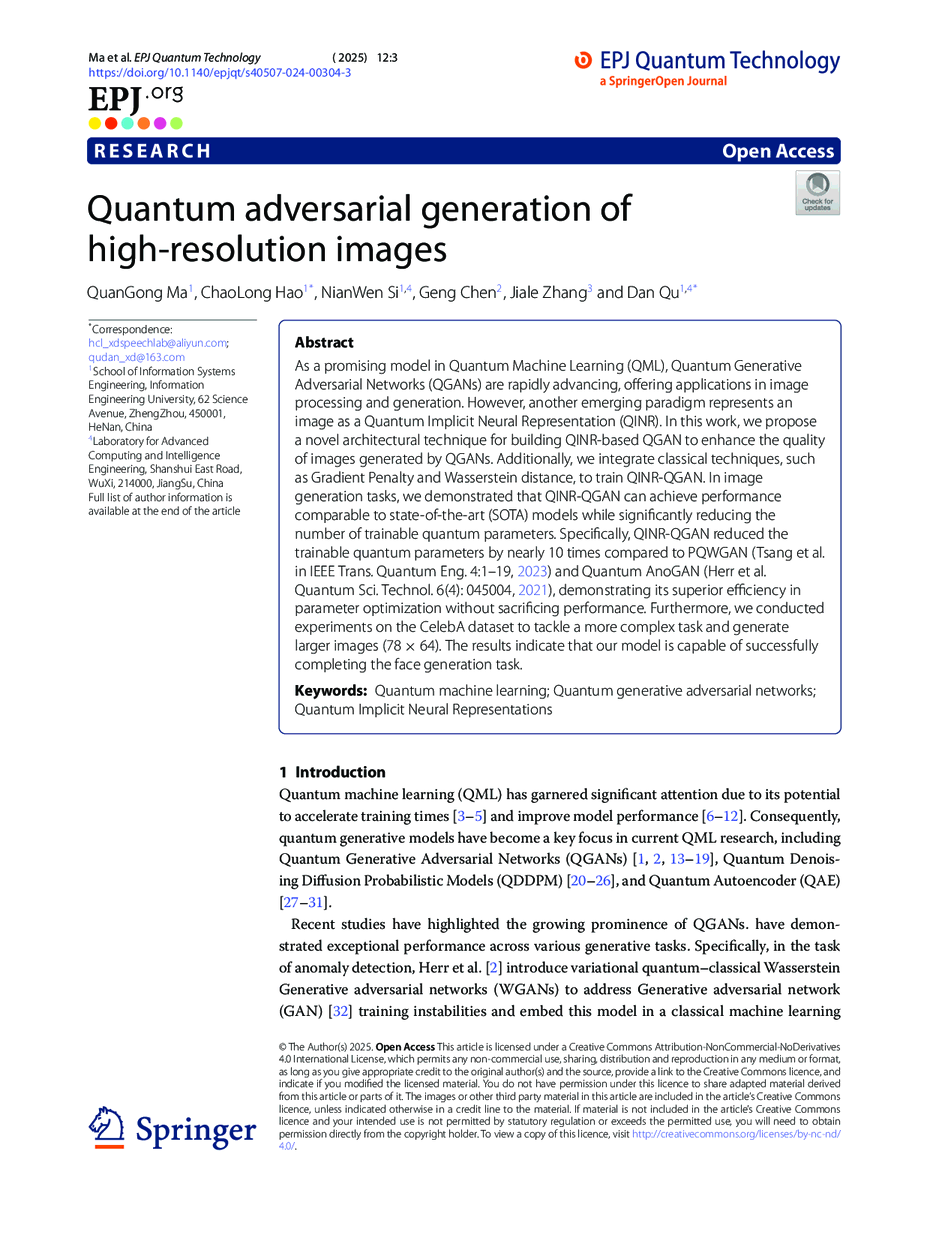https://doi.org/10.1140/epjqt/s40507-024-00304-3
Research
Quantum adversarial generation of high-resolution images
1
School of Information Systems Engineering, Information Engineering University, 62 Science Avenue, 450001, ZhengZhou, HeNan, China
2
School of Computer Science and Engineering, University of Electronic Science and Technology of China, 2006 Xiyuan Avenue, 610054, Chengdu, SiChuan, China
3
College of Computer Science and Technology, Jilin University, 2699 Qianjin Street, 130012, ChangChun, JiLin, China
4
Laboratory for Advanced Computing and Intelligence Engineering, Shanshui East Road, 214000, WuXi, JiangSu, China
a
hcl_xdspeechlab@aliyun.com
b
qudan_xd@163.com
Received:
26
November
2024
Accepted:
29
December
2024
Published online:
8
January
2025
As a promising model in Quantum Machine Learning (QML), Quantum Generative Adversarial Networks (QGANs) are rapidly advancing, offering applications in image processing and generation. However, another emerging paradigm represents an image as a Quantum Implicit Neural Representation (QINR). In this work, we propose a novel architectural technique for building QINR-based QGAN to enhance the quality of images generated by QGANs. Additionally, we integrate classical techniques, such as Gradient Penalty and Wasserstein distance, to train QINR-QGAN. In image generation tasks, we demonstrated that QINR-QGAN can achieve performance comparable to state-of-the-art (SOTA) models while significantly reducing the number of trainable quantum parameters. Specifically, QINR-QGAN reduced the trainable quantum parameters by nearly 10 times compared to PQWGAN (Tsang et al. in IEEE Trans. Quantum Eng. 4:1–19, 2023) and Quantum AnoGAN (Herr et al. Quantum Sci. Technol. 6(4): 045004, 2021), demonstrating its superior efficiency in parameter optimization without sacrificing performance. Furthermore, we conducted experiments on the CelebA dataset to tackle a more complex task and generate larger images ( ). The results indicate that our model is capable of successfully completing the face generation task.
). The results indicate that our model is capable of successfully completing the face generation task.
Key words: Quantum machine learning / Quantum generative adversarial networks / Quantum Implicit Neural Representations
© The Author(s) 2025
 Open Access This article is licensed under a Creative Commons Attribution-NonCommercial-NoDerivatives 4.0 International License, which permits any non-commercial use, sharing, distribution and reproduction in any medium or format, as long as you give appropriate credit to the original author(s) and the source, provide a link to the Creative Commons licence, and indicate if you modified the licensed material. You do not have permission under this licence to share adapted material derived from this article or parts of it. The images or other third party material in this article are included in the article’s Creative Commons licence, unless indicated otherwise in a credit line to the material. If material is not included in the article’s Creative Commons licence and your intended use is not permitted by statutory regulation or exceeds the permitted use, you will need to obtain permission directly from the copyright holder. To view a copy of this licence, visit http://creativecommons.org/licenses/by-nc-nd/4.0/.
Open Access This article is licensed under a Creative Commons Attribution-NonCommercial-NoDerivatives 4.0 International License, which permits any non-commercial use, sharing, distribution and reproduction in any medium or format, as long as you give appropriate credit to the original author(s) and the source, provide a link to the Creative Commons licence, and indicate if you modified the licensed material. You do not have permission under this licence to share adapted material derived from this article or parts of it. The images or other third party material in this article are included in the article’s Creative Commons licence, unless indicated otherwise in a credit line to the material. If material is not included in the article’s Creative Commons licence and your intended use is not permitted by statutory regulation or exceeds the permitted use, you will need to obtain permission directly from the copyright holder. To view a copy of this licence, visit http://creativecommons.org/licenses/by-nc-nd/4.0/.





